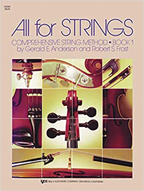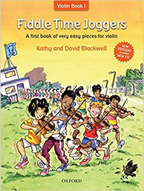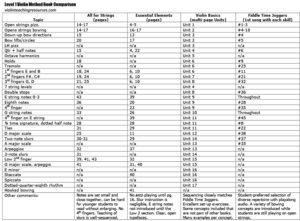Cut to the Coda: The method book comparison chart printable!
Method books for music readers
I teach young beginner violin students to read music from the start. I use method book series to teach concepts in a logical sequence, but have yet to find “the perfect” method book that exactly matches my preferred teaching progression.
Most published violin method books in the U.S.A. were written for elementary-age mixed-instrument school music classes. So sometimes the sequence for violin students delays the introduction of the E-string notes (Essential Elements Book 1), because the cello and viola students in the class don’t have an E string. Some books advance more quickly than others, with fewer pages and examples between introductions of new concepts. Some Level 1 books leave out skills that other Level 1 books cover, like low second finger. All seem to be written for group instead of individual instruction. And most haven’t been updated for 20 years or more. Witness “String Builder,” unchanged since the 1960’s and the book used in my 3rd grade orchestra class!
An old favorite…
 My go-to violin method book for 6-to-12-year-old beginners has been All for Strings Violin Book 1. The pacing is a little slow for the older students, but the pictures and explanations are clear. The book covers the concepts I teach in about the order that I like to teach them. It also comes with a correlating theory workbook. It teaches the notes “string-wise”: fingers 1, high 2, 3 on the D, A, G and E strings in that order. (No 4th finger, though.)
My go-to violin method book for 6-to-12-year-old beginners has been All for Strings Violin Book 1. The pacing is a little slow for the older students, but the pictures and explanations are clear. The book covers the concepts I teach in about the order that I like to teach them. It also comes with a correlating theory workbook. It teaches the notes “string-wise”: fingers 1, high 2, 3 on the D, A, G and E strings in that order. (No 4th finger, though.)
Adding repertoire….
 My favorite book of beginner repertoire is Oxford University Press’s Fiddle Time Joggers, followed by its companions Fiddle Time Runners and Fiddle Time Sprinters. The Joggers book has no instructional content, so it is clearly designed to be used by an individual teacher. It is sequenced “finger-wise”: beginning with tunes played only on the four open strings, then adding all the first-finger notes, then 2nd, 3rd and 4th fingers. By the end of this book, the student will be playing all the notes that were introduced in All for Strings Book 1, but learned in a different order. The combination of the two books gives me a “crosshatch” way of building note-recognition, both vertically (up each individual string) and horizontally (across all strings with one finger at a time).
My favorite book of beginner repertoire is Oxford University Press’s Fiddle Time Joggers, followed by its companions Fiddle Time Runners and Fiddle Time Sprinters. The Joggers book has no instructional content, so it is clearly designed to be used by an individual teacher. It is sequenced “finger-wise”: beginning with tunes played only on the four open strings, then adding all the first-finger notes, then 2nd, 3rd and 4th fingers. By the end of this book, the student will be playing all the notes that were introduced in All for Strings Book 1, but learned in a different order. The combination of the two books gives me a “crosshatch” way of building note-recognition, both vertically (up each individual string) and horizontally (across all strings with one finger at a time).
A new contender!
 Recently a new book showed up on my radar. “Violin Basics” is published in the UK. It matches the presentation of the Fiddle Time books better than anything I’ve seen from U.S. publishers. It also seems more innovative than the classic method books. There are warm-up and set-up exercises pioneered by Paul Rolland and championed by Mimi Zweig for proper posture and elimination of tension. Online audio demos are available. “Advanced” skills include sliding up to octave harmonics, left-hand pizzicato, and double stops. These are actually very valuable to introduce in the first year of violin study.
Recently a new book showed up on my radar. “Violin Basics” is published in the UK. It matches the presentation of the Fiddle Time books better than anything I’ve seen from U.S. publishers. It also seems more innovative than the classic method books. There are warm-up and set-up exercises pioneered by Paul Rolland and championed by Mimi Zweig for proper posture and elimination of tension. Online audio demos are available. “Advanced” skills include sliding up to octave harmonics, left-hand pizzicato, and double stops. These are actually very valuable to introduce in the first year of violin study.
Unfortunately, the authors have not published a follow-up Book 2 yet. I hope they will, soon!
Method book comparison chart!
 To decide if I wanted to make a change this year from All for Strings to Violin Basics, I made a chart showing the concepts covered in each book, their sequencing, and any omissions between books. I also included Essential Elements Violin Book 1, which I use for older beginners or those who have already learned note-reading on a different instrument. The results were eye-opening and have confirmed my decision to use Violin Basics with new students this year. I hope you find this chart useful as you evaluate your book selections too. Drop a comment with your experiences of different method books! Is there another series I should look into?
To decide if I wanted to make a change this year from All for Strings to Violin Basics, I made a chart showing the concepts covered in each book, their sequencing, and any omissions between books. I also included Essential Elements Violin Book 1, which I use for older beginners or those who have already learned note-reading on a different instrument. The results were eye-opening and have confirmed my decision to use Violin Basics with new students this year. I hope you find this chart useful as you evaluate your book selections too. Drop a comment with your experiences of different method books! Is there another series I should look into?
